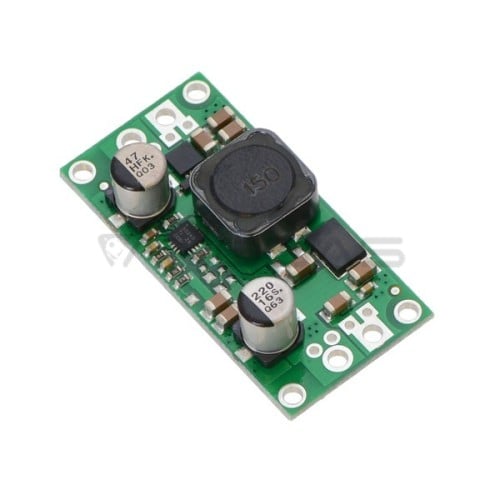These step-up/step-down regulators take an input voltage from 3 V to 30 V and increase or decrease it as necessary to produce an adjustable 4 V to 12 V or 9 V to 30 Voutput, depending on the version. They are switching regulators (also called switched-mode power supplies (SMPS) or DC-to-DC converters) with a single-ended primary-inductor converter (SEPIC) topology, and they have a typical efficiency between 80% and 90%. The available output current is a function of the input voltage, output voltage, and efficiency (see the Typical Efficiency and Output Current section below), but it will be around 2 A when the input voltage is close to the output voltage.
The S18V20x regulator family consists of the two adjustable-output versions mentioned above along with five versions that output a fixed 5 V, 6 V, 9 V, 12 V, or 24 V. The different versions of the board all look very similar, so the bottom silkscreen includes a blank space where you can add your own distinguishing marks or labels. This product page applies to both adjustable-output versions of the S18V20x family.
The flexibility in input voltage offered by these regulators is especially well-suited for battery-powered applications in which the battery voltage begins above the desired output voltage and drops below the target as the battery discharges. Without the typical restriction on the battery voltage staying above the required voltage throughout its life, new battery packs and form factors can be considered. For example:
- A 4-cell battery holder, which might have a 6 V output with fresh alkalines or a 4.0 V output with partially discharged NiMH cells, can be used with the 5V version of this regulator to power a 5 V circuit.
- A disposable 9 V battery powering a 5V circuit can be discharged to under 3 V instead of cutting out at 6 V, as with typical linear or step-down regulators.
- The 6V version of this regulator can be used to enable a wide range of power supply options for a hobby servo project.
The no-load quiescent will typically be between 1 mA and 5 mA for most combinations of input and output voltages, though the combination of a very high output voltage and a very low input voltage (e.g. when boosting from 3 V in to 24 V out) can result in quiescent currents on the order of a few dozen milliamps.
The ENABLE pin can be used to put the board in a low-power state that reduces the quiescent current to between 10 and 20 µA per volt on VIN (e.g. approximately 30 µA with 3 V in and 500 µA with 30 V in).
This regulator has built-in reverse-voltage protection, over-current protection, thermal shutdown (which typically activates at 165°C), and an under-voltage lockout that causes the regulator to turn off when the input voltage is below 2.5 V (typical).
For similarly powerful boost-only regulators, consider our U3V50x regulator family, which are typically more appropriate if you know that your input voltage will always be lower than your output voltage.
Specifications:
- Input voltage: 2.9 V to 32 V1
- Output adjustable from 4 V to 12 V or 9 V to 30 V
- Typical maximum output current: 2 A (when input voltage is close to the output voltage; the Typical Efficiency and Output Current section below shows how the achievable output current depends on input and output voltages)
- Integrated reverse-voltage protection (up to 30 V), over-current protection, over-temperature shutoff, and under-voltage lockout
- Typical efficiency of 80% to 90%, depending on input voltage, output voltage, and load
- Four mounting holes for #2 or M2 screws
- Compact size: 1.7″ × 0.825″ × 0.38″ (43 × 21 × 10 mm)
- Smaller holes for 0.1″ header pins and larger holes for terminal blocks offer several options for connecting to the board


